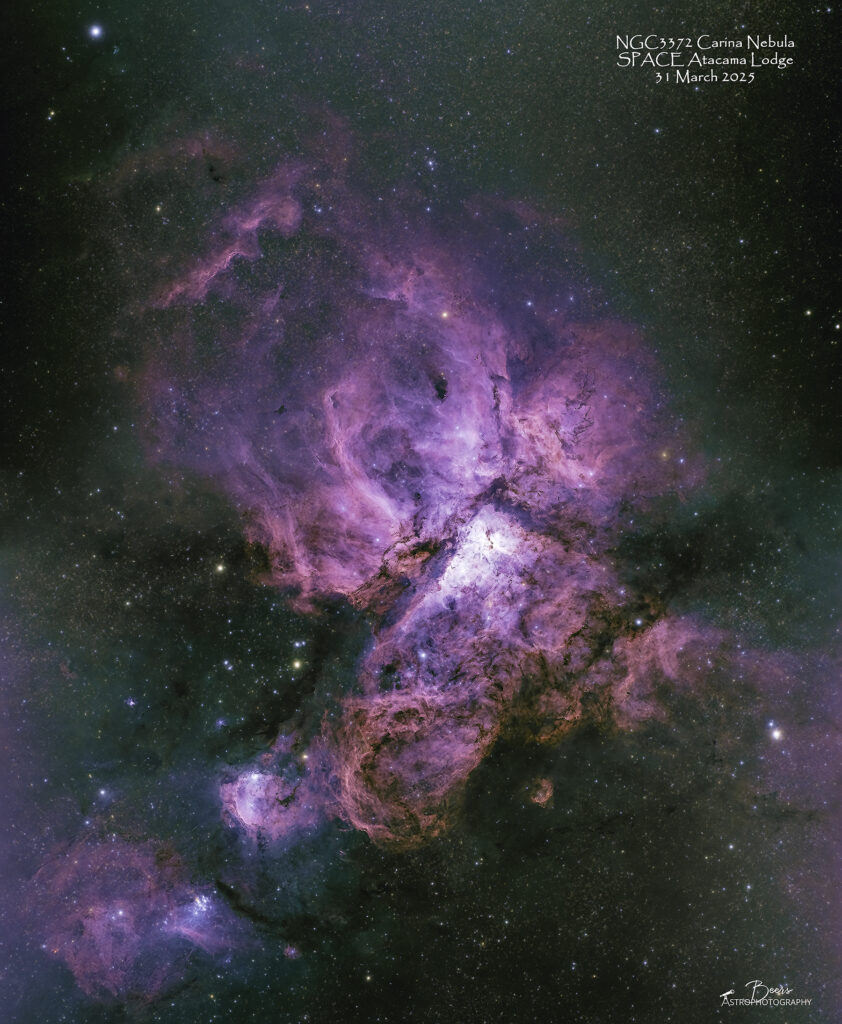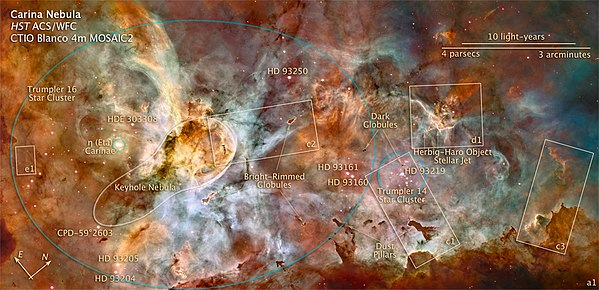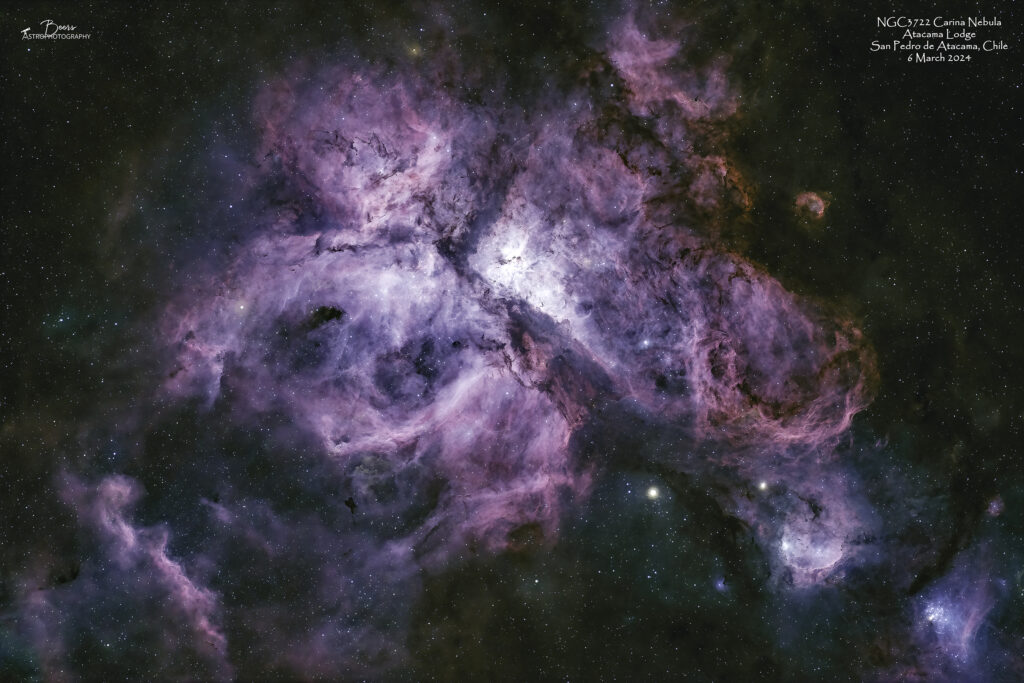
Fun facts
The Carina Nebula or Eta Carinae Nebula (catalogued as NGC 3372; also known as the Great Carina Nebula) is a large, complex area of bright and dark nebulosity in the constellation Carina, located in the Carina–Sagittarius Arm of the Milky Way galaxy. The nebula is approximately 8,500 light-years (2,600 pc) from Earth
The nebula has within its boundaries the large Carina OB1 association and several related open clusters, including numerous O-type stars and several Wolf–Rayet stars. Carina OB1 encompasses the star clusters Trumpler 14 and Trumpler 16. Trumpler 14 is one of the youngest known star clusters at half a million years old and contains stars like the O2 supergiant HD 93129A. Trumpler 16 is the home of many extremely luminous stars, such as WR 25 and the Eta Carinae star system. Trumpler 15, Collinder 228, Collinder 232, NGC 3324, and NGC 3293 are also considered members of the association. NGC 3293 is the oldest and furthest from Trumpler 14, indicating sequential and ongoing star formation.
The nebula is one of the largest diffuse nebulae in our skies. Although it is four times as large as and even brighter than the famous Orion Nebula, the Carina Nebula is much less well known due to its location in the southern sky. It was discovered by Nicolas-Louis de Lacaille in 1752 from the Cape of Good Hope.
The Carina Nebula was selected as one of five cosmic objects observed by the James Webb Space Telescope, as part of the release of its first official science images. A detailed image was made of an early star-forming region of NGC 3324 known as the Cosmic Cliffs.
Eta Carinae is a highly luminous hypergiant star. Estimates of its mass range from 100 to 150 times the mass of the Sun, and its luminosity is about four million times that of the Sun.
This object is currently the most massive star that can be studied in great detail, because of its location and size. Several other known stars may be more luminous and more massive, but data on them is far less robust. (Caveat: Since examples such as the Pistol Star have been demoted by improved data, one should be skeptical of most available lists of “most massive stars”. In 2006, Eta Carinae still had the highest confirmed luminosity, based on data across a broad range of wavelengths.) Stars with more than 80 times the mass of the Sun produce more than a million times as much light as the Sun. They are quite rare—only a few dozen in a galaxy as big as ours—and they flirt with disaster near the Eddington limit, i.e., the outward pressure of their radiation is almost strong enough to counteract gravity. Stars that are more than 120 solar masses exceed the theoretical Eddington limit, and their gravity is barely strong enough to hold in its radiation and gas, resulting in a possible supernova or hypernova in the near future.
Eta Carinae’s effects on the nebula can be seen directly. Dark globules and some other less visible objects have tails pointing directly away from the massive star. The entire nebula would have looked very different before the Great Eruption in the 1840s surrounded Eta Carinae with dust, drastically reducing the amount of ultraviolet light it put into the nebula.
The Wikipedia site (https://en.wikipedia.org/wiki/Carina_Nebula) contains a detailed description of all the objects within the Carina Nebula, including several that are captured within my image. It also includes the map below.

Location: RA: 10h 45m 08.5s / DEC: −59° 52′ 04″
Distance: 8500 light years
Apparent magnitude: +1.0
Apparent dimensions: 2°x2°
Constellation: Carina
Designations: NGC3372, ESO 128-EN013, GC 2197, h 3295, Caldwell 92
Notable Features: Eta Carinae, Keyhole Nebula, Many open clusters & dark nebulae
{ From https://en.wikipedia.org/wiki/Carina_Nebula }
Capture & Processing Notes
I’d imaged the Carina Nebula as a single tile during my 2024 Atacama trip and it didn’t quite fit into the frame. So, I added a 2-tile plan to my list of targets for the 2025 trip. I hadn’t prioritized it very hightly, but it turned out that, because I had decided to forego the Vela SNR imaging during this trip (because of the odd timing (setting at 0300), Carina worked it’s way onto the play list. It’s timing was perfect to be the night’s first target, followed when it set at about 0245 by the Anteater Nebula that rose at 0230.
On this, my last night of imaging for this trip, everything went very smoothly. The polar alignment took less than 2 minutes (including capturing screen shots of the Polemaster screen for further reference) and required no adjustment to the mount location. The start-up and first tile’s collection went very well. I came out at 23:45 to do the meridian flip. There were two subframes left on the Tile#1 collection plan, so I let it reacquire on that tile. Then, as it was collected the first subframe after the meridian flip, I did the math and determined that I should have just started on Tile#2 because it wasn’t going to get its fair share of time. So, I changed the number of frames on Tile #1 to 36 (it was collecting that subframe) and stayed outside to watch the collection of that subframe and the switch to the second tile. All seemed to go well with the collection. I came out at 0245 to shut down this sequence and shift to the IC4812 Anteater Nebula for the rest of the night
In stacking the data the following morning, the individual tiles were good, but the mosaic was a hot mess! I followed all the same steps that I’d followed all week, successfully. But this time the Tile#2 was stretched and portions of it were missing. I tried a couple of times to redo the mosaic, all with the same result. I took screen shots of the individual tiles and the mosaic result – I sent them to both Ann Chavtur and Nico Carver to see if they have advice on what I’d done wrong – and if all else fails, when I get home, I’ll put the mosaic together by hand from the individual tiles in Photoshop. But, this WILL nag at me until I figure it out!
As I pasted these images into the journal, it occurred to me, a probable cause (but I don’t know the fix). The meridian flip was just about at the tile switch in the sequence. On all the other mosaics, I have done the switch to the second tile in conjunction with the meridian flip. For this one, I thought I had the time for the last two subframes on Tile#1 after the meridian flip. So, I did the meridian flip and let SGP take one subframe on Tile #1, then watched as it switched to Tile #2. So, I concluded that Tile#2 needed to be flipped 180 degrees to stitch properly with Tile #1, since all its subframes were taken after the meridian flip. I tried to do that flip with the APP “perspective” angle slider – but got the same mosaic result. Is there a way to flip the FITS file by 180 degrees?
I got an email back from Nico stating that he was willing to give the mosaicking a try in PixInsight if I sent him the data. So, I sent him the two .FITS files via Google Drive. He came back shortly saying that there was a black border around the second tile that was causing the issue. He sent me a cropped version of the tiles and a mosaic that he’d successfully produced from them. (It made me think an investment in PixInsight might be worth it!)
I tried to mosaic Nico’s cropped tiles into my “own” mosaic and got the same “cactus” shaped result. So, I decided that I would give the stacking and mosaic-ing another try when I get home and am working on them with my “big” processing computer.
The rest of the story! When I got home and starting the “re-processing” process on the BeersAP Desktop, I discovered that APP saves not only the window configurations (like it warns you), but it also saves the settings – so I had been doing the individual tile stacking with some mosaic settings in the register panel (start/stop values = 5/10). When I stacked the individual tiles using the proper settings (start/stop = 1/5), I got tiles that stitched together perfectly well. Apparently, after I composed the mosaic of the Rho Ophiuchi on my laptop, I didn’t reset the values, so all the rest of the tiles processed with the laptop were stacked with the incorrect parameters…something that only became obvious when I tried to mosaic the improperly stacked tiles! So now, before I shut down APP, I reset the parameters to “normal” settings in the Register and Integrate tabs.
Sequence plan: Gain 158, Offset 30, Temp 0°C.
Tile #1: 36x5min, captured 31Mar2025, 20:39CDT – 23:59CDT. Total exposure time: 3:00hrs.
Tile #2: 31x5min, captured 1Apr2025, 00:05CDT – 02:52CDT. Total exposure time: 2:35hrs.
Mosaic: 67x5min, captured 31Mar2025, 20:39CDT – 1Apr2025, 02:52CDT. Total: 5:35hrs.
Processing summary: Captured with SGP. Stacked in APP. Star removal with Starnet++. Processed in LR/PS
Equipment
All equipment controlled by HP Probook (DSO CTRL 1) Windows 11 laptop running Sequence Generator Pro v4.4.1.1441.
- Imaging (ASI2400-SC): ZWO ASI2400MC imaging camera; (Southern Cross) Askar FRA600 108mm f/5.6 Quintuplet Petzval Flat-Field Astrograph
- Mount: Rainbow Astro RST-135E (controlled by iHubo ASCOM driver)
- Polar alignment: QHYCCD camera (controlled by Polemaster for polar alignment)
- Autoguiding: Orion 60mm Multi-Use Guide Scope with Orion StarShoot AutoGuider Pro Mono Astrophotography Camera (controlled by PHD2)
- Autofocuser: ZWO EAF Electronic Automatic Focuser (EAF-5V-STD)
Summary
Captured: Mosaic: 67x5min, captured 31Mar2025, 20:39CDT – 1Apr2025, 02:52CDT. Total: 5:35hrs.
Location: San Pedro de Atacama Celestial Explorations (SPACE) Atacama Lodge, Chile
Equipment: Southern Cross on Rainbow Astro RST-135E
Processing: Captured with SGP. Stacked in APP. Star removal with Starnet++. Processed in LR/PS
Other images of the Carina Nebula

Capture & Processing Notes
This was my first image captured during my long-planned and much-anticipated trip to San Pedro de Atacama, Chile – for an opportunity to see and photograph the Southern Hemisphere targets that can’t be seen from the Northern Hemisphere. Upon arrival at the Atacama Lodge in San Pedro de Atacama, Chile (after approximately 32 hours of travel), although I was a bit exhausted and conflicted, I didn’t want to miss the opportunity of a clear night – especially since the forecast called for clouds throughout rest of the nights after the first. I was choosing to ignore that horrible prediction, but didn’t want to risk it, so I set about getting the gear set up in the area behind (to the east) of Atacama Lodge #1, while Danita went to get some groceries.
I got everything set up, got all the RST-135 mount’s new location activities accomplished, and started on the process of finding the Southern Hemisphere pole star (Sigma Octantis) just as dusk was setting in. Even though I had researched what to look for, watched videos on the process in Polemaster, it was still a very difficult process, as the pole star is very faint. When Danita returned from her grocery adventure, she came out to help. The two of us struggled for a couple of hours, until finally, I decided – since this was THE crucial first step in having this trip meet its objective of photographing the Southern Hemisphere objects – I was going to go and ask Alain Maury (the Atacama Lodge owner) for help. He was at the observatory across the way from our lodge, grabbed his laser pointer (a VERY powerful laser pointer) and a pair of binoculars to come and save the night. He did just that!! Alain easily pointed out the pole star and pointed the mount so that it and those that need to be in the polar alignment template were in the center of my Polemaster screen – allowing me to polar align the mount and get on with the night’s imaging. Whew!! Trip disaster averted – THANK YOU Alain!
The other issue that I ran into was the mount returning to “home” throughout the night to its Northern Hemisphere home position (pointing west). I continually used the hand controller to put it into the correct home position before starting any sequence. Got the sequence going – the plate solving and autofocus worked well, the autoguider struggled to resume after pausing for the autofocus, then the plate solving was all star traily. Reboot, shut everything down, and start again (yes, Danita stayed out there for the entire show!) finally got the sequence going at about 2300.
The errant home position issue came to haunt me a little bit during the meridian flip. Once I did the meridian flip (which was successful) and the sequence began, I decided to wait for one subframe to capture to make sure everything was going to work out well. I was faced with a “would you like to pause for the meridian flip” prompt! I selected “yes” – wrong answer – had to abort and start anew. Second time, same thing – I said “no” and the sequence continued. But, I was a little spooked that I was going to get prompted every 5 minutes for the rest of the night, so I aborted, turned off auto-meridian flip and started over again. That worked – no more prompts and successful collect for the rest of the night.
I stacked the images in APP each morning to check on the capture. I waited on further processing until I was home with the full suite of software on “BeersAPStation” work station – but was very encouraged with the first night’s data (and the telescope has not been moved, so we should have a quicker start on night #2!).
Sequence Plan: Gain: 158, Temp: -0°C, offset=30; 6 March 2024 (6Mar2024, 2308 Chilean Daylight Time (CDT) – 7Mar2024, 0637CDT); 85x5min; Total exposure time: 425 minutes, 7:05 hours.
Processing Summary: Captured with SGP. Stacked in APP (Adaptive Airy Disc). Star removal with Starnet++. Processed in LR/PS
Equipment
All equipment controlled by HP Probook (DSO CTRL 1) Windows 10 laptop running Sequence Generator Pro v4.3.0.1305.
- Polar alignment: QHYCCD camera (controlled by Polemaster for polar alignment)
- Imaging: (Southern Cross) Askar FRA600 on Rainbow Astro RC-135E, ZWO ASI2400MC#1 camera
- Autofocuser: ZWO EAF ( Electronic Automatic Focuser)
- Mount: Rainbow Astro RST-135E (controlled by iHubo ASCOM driver)
- Autoguiding: Orion 60mm Multi-Use Guide Scope with Orion StarShoot AutoGuider Pro Mono Astrophotography Camera (controlled by PHD2)
Summary
Captured: 6 March 2024 (6Mar2024, 2308 Chilean Daylight Time (CDT) – 7Mar2024, 0637CDT); 85x5min; Total exposure time: 425 minutes, 7:05 hours.
Location: San Pedro de Atacama Celestial Explorations (SPACE) Atacama Lodge, Chile
Equipment: Southern Cross on Rainbow Astro RST-135E
Processing: Captured with SGP. Stacked in APP. Star removal with Starnet++. Processed in LR/PS
